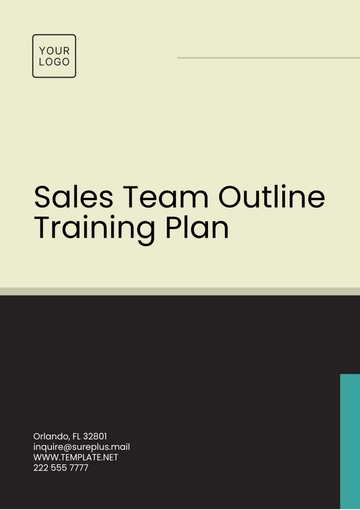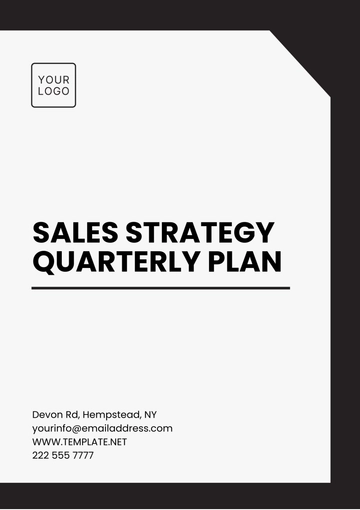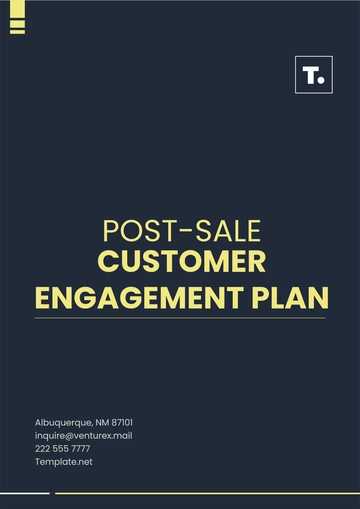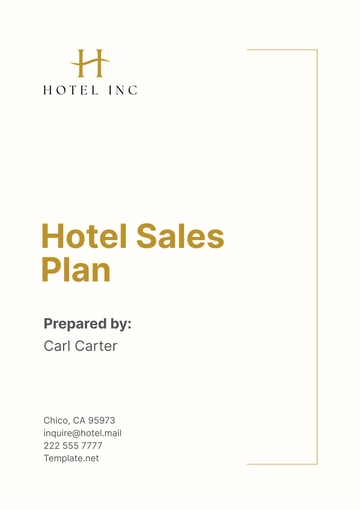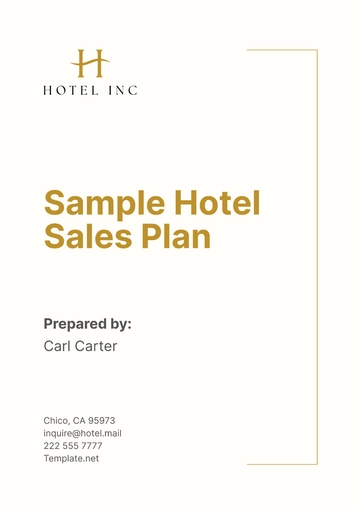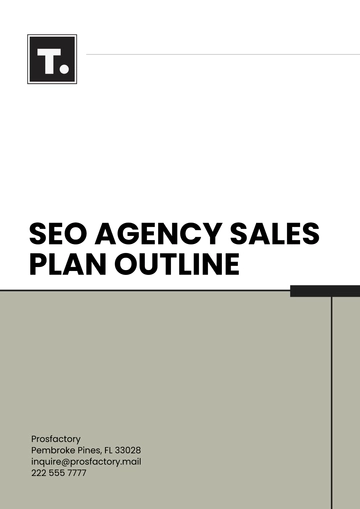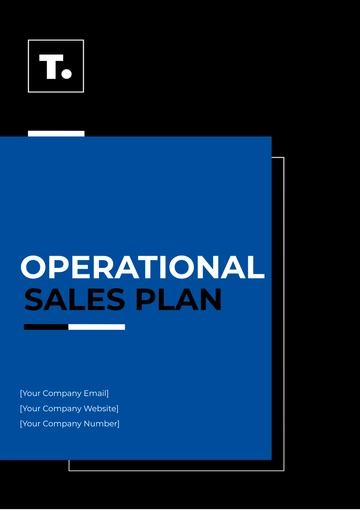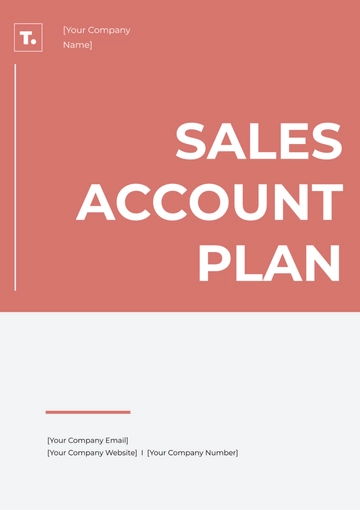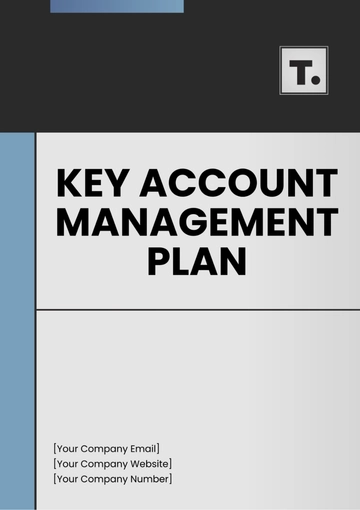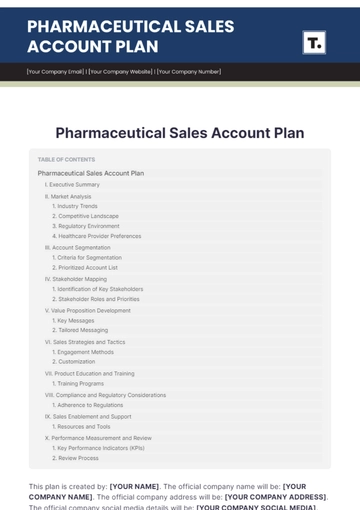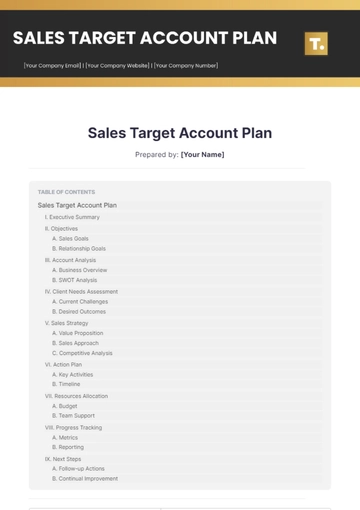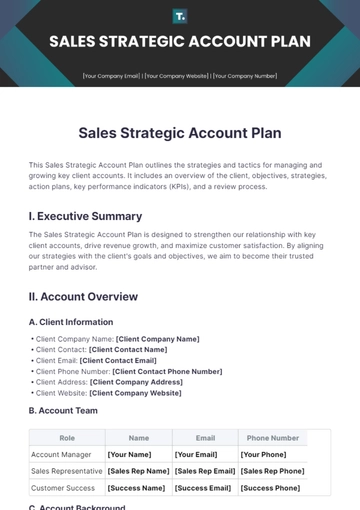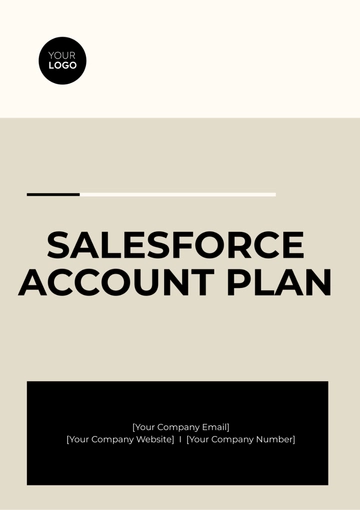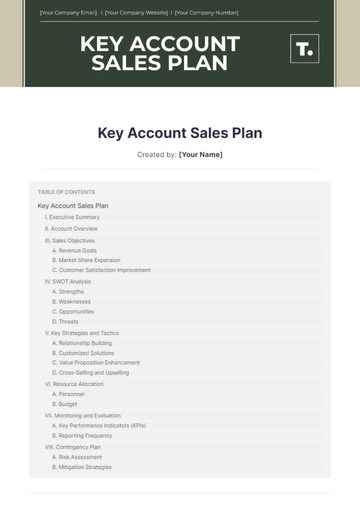Free Sales Collateral Strategy Plan

I. Introduction
[Your Company Name] has crafted this comprehensive guide to serve as the cornerstone of our sales and marketing efforts, focusing on creating, distributing, and evaluating impactful sales collateral. The document aims to be an indispensable resource for our entire organization, from our sales team right through to marketing and executive leadership.
In an increasingly competitive marketplace, having effective sales collateral is not just an option—it's a necessity. With that in mind, this strategy plan takes a holistic approach to ensure that all customer touchpoints are covered. It addresses the unique needs and pain points of our target audience, aligning our collateral types and content with their specific challenges and objectives.
Beyond just itemizing types of collateral and content topics, we delve into the distribution channels that we will leverage to get our materials in front of the right eyes. We outline measurable Key Performance Indicators (KPIs) to evaluate our success, along with a well-defined timeline to keep us on track.
This strategy plan does not exist in a vacuum; it will be subject to regular reviews and updates to ensure its ongoing effectiveness. We are committed to maximizing customer engagement and driving revenue growth as we navigate the future. Thank you for being a part of this exciting journey.
II. Objectives
The primary objectives of this sales collateral strategy are designed to provide a measurable framework for our actions and efforts throughout the year 2050 and beyond. Each objective is rooted in the overarching goals of our business and aims to make a significant impact in key areas. Below are the elaborations on our primary objectives:
A. To Increase Sales Revenue by 20% in the Next Fiscal Year
Increasing sales revenue is paramount for the growth and sustainability of [Your Company Name]. By leveraging highly targeted and informative sales collateral, we aim to guide prospective customers through the sales funnel more effectively. This will include addressing pain points, offering solutions, and demonstrating value in a manner that is calculated to boost our closing rates and increase customer lifetime value.
B. To Improve Customer Engagement by 15%
In today's competitive landscape, customer engagement is more crucial than ever for maintaining a robust sales pipeline and fostering long-term relationships. Through the use of engaging, relevant, and value-added collateral, we plan to capture and hold the interest of our audience. This will be quantified through metrics like click-through rates, time spent on content, and the number of interactions, aiming for an overall improvement of 15%.
C. To Enhance Brand Awareness and Positioning
Our third objective revolves around brand building. The collateral we produce will not only serve the purpose of sales enablement but also aim to solidify our brand's position in the market. By maintaining a consistent voice, look, and feel across all collateral, and by addressing topics that resonate with our target audience, we aim to enhance recognition and trust in our brand.
III. Target Audience
Understanding the target audience is a cornerstone of any effective sales collateral strategy. It informs not only the type of content we create but also the mediums through which they are distributed. This chapter aims to provide an in-depth analysis of the audience segments that [Your Company Name] targets, along with their specific pain points and the types of collateral best suited to engage them. By doing this, we aim to ensure that our sales collateral is as impactful as possible, helping us achieve the objectives outlined in the previous chapter.
Audience Segment | Detailed Pain Points | Collateral Types | Rationale for Collateral Type |
Small and Medium-sized Businesses (SMBs) | Budget constraints, need for high ROI solutions that are easy to implement and cost-effective. | Whitepapers, eBooks | Provide in-depth solutions to specific problems, offering real value for informed purchasing decisions. |
Enterprises | Complexity in the range of solutions available, challenges with integration into existing systems, and concerns about scalability. | Case Studies, Videos | Effectively address complexity by showing real-world examples of successful implementations. Rich content allows tackling complex topics effectively. |
Individual Users | Ease of use is a primary concern due to the lack of technical support or specialized skills. Individuals often prefer quick, digestible information. | Blogs, Infographics | Offer easily digestible information, helping individual users understand product features and benefits for a simplified purchase decision process. |
IV. Types of Collateral
We delve into the different types of collateral that [Your Company Name] plans to utilize in its sales strategy. Each form of collateral serves a distinct purpose and targets specific pain points, ensuring that we cater to the varied needs of our audience segments. Below is a detailed look at each type:
Whitepapers. Whitepapers are research-based, long-form content that provide an in-depth look into complex issues, offering robust solutions and actionable insights. They are particularly effective for SMBs and enterprises that seek thorough understanding and need to solve complex problems. By creating whitepapers, we aim to establish ourselves as thought leaders in the industry, providing valuable content that can guide potential customers toward making informed decisions.
eBooks. eBooks are versatile, digital publications that allow for more extensive treatment of subjects compared to blogs or whitepapers. They can range from how-to guides to industry trend analyses. Like whitepapers, eBooks are especially valuable for SMBs looking for comprehensive, yet accessible information. eBooks are an excellent way for [Your Company Name] to showcase expertise in an engaging and portable format.
Case Studies. Case studies offer real-world examples of how our products or services have solved problems for our customers. They are particularly effective for enterprises, as they show our solutions at work in a similar setting. Case studies lend credibility to our offerings and are instrumental in moving potential customers through the sales funnel.
Blogs. Blogs serve as shorter, more digestible pieces of content that can address a wide variety of topics. They are well-suited for individual users who seek quick answers to their questions or want to learn about our products' features and benefits. Blogs also offer the advantage of quick updates, allowing us to stay timely and relevant.
Infographics. Infographics provide visual representations of data, concepts, or processes, making complex information easier to understand. These are particularly useful for individual users who appreciate quick, easily digestible insights. Infographics are excellent tools for enhancing user engagement and can be easily shared, increasing our brand’s visibility.
Videos. Videos offer dynamic, visually engaging content that can effectively explain complex topics or demonstrate product usage. They are well-suited for enterprises that require an in-depth look into product features and benefits. Videos allow for storytelling, adding an emotional dimension to the sales process.
Webinars. Webinars are live or pre-recorded online events, usually focused on a specific topic or set of topics. They offer an interactive way to engage with potential customers, answer their questions in real-time, and build relationships. Webinars are excellent tools for both lead generation and nurturing, serving a broad range of our target audience from SMBs to enterprises.
V. Content Strategy
This chapter outlines [Your Company Name]'s content strategy for the year 2050, focusing on the message framework targeted at our different audience segments and the content calendar to ensure timely and consistent delivery. This strategy aims to align our sales collateral with the specific needs, interests, and pain points of our target audience, thus enhancing engagement and conversion rates.
A. Message Framework
The message framework aims to tailor our collateral types to the unique needs and pain points of each audience segment. Here's how we break it down:
Audience | Message | Collateral Type | Details |
SMBs | Affordable Solutions | Whitepapers | Content will focus on cost-effective solutions for budget-conscious businesses. Topics could include ROI maximization and lean operational strategies. |
Enterprises | Streamline Operations | Videos | Videos will highlight how our products can simplify complex processes and integrate seamlessly with existing systems. Case studies of successful implementations may be included. |
Individual Users | Simple and Intuitive | Blogs | Blogs will provide easy-to-understand guides and tips, focusing on the ease-of-use and low learning curve of our products. |
B. Content Calendar
To ensure that we produce collateral consistently and strategically, we've devised a content calendar outlining the types of content to be produced each month and their respective focus areas.
Month | Collateral Type | Topic | Details |
January | Whitepaper | Maximizing ROI | A deep-dive into strategies SMBs can adopt to maximize ROI. |
February | eBook | User Guide | Comprehensive guide aimed at individual users, covering features and tips for using our product effectively. |
March | Videos | Streamlining Operations | How-to videos for enterprises on integrating our solution into their workflows. |
April | Blog | Product Features | Blog posts explaining the features of our latest product release. |
May | Case Studies | Customer Success | Real-life examples of how our solutions have positively impacted customer operations. |
June | Webinar | Q2 Product Updates | A live event discussing updates, new features, and best practices. |
July | Infographic | Industry Trends | Visual representation of key trends affecting our target audience. |
August | Whitepaper | Scalability | Discussion on how our solutions can scale as your business grows. |
September | Videos | Use Cases | Real-world scenarios showcasing the applications of our products. |
October | Blog | Tips and Tricks | Practical advice on getting the most out of our products. |
November | eBook | Year-end Review | A roundup of all the updates, features, and milestones of the year. |
December | Webinar | Q1 Sneak Peek | A preview of what to expect in the first quarter of the upcoming year. |
VI. Distribution Channels
In order to maximize the reach and effectiveness of our sales collateral, it's crucial to deploy a multi-channel distribution strategy. The following distribution channels have been selected for their proven ability to effectively engage our target audience segments.
Company Website. Our company website serves as the primary hub for all our sales collateral. Whether it's whitepapers, case studies, or blog posts, our website will feature a dedicated section for resources where visitors can download or view these materials. SEO optimization will ensure that our collateral is easily discoverable, driving organic traffic and boosting engagement rates.
Email Marketing. Email remains one of the most effective channels for direct communication with our audience. We will implement a segmented email marketing strategy to distribute tailored content directly to the inboxes of our prospective and current customers. This will include periodic newsletters that feature new collateral, as well as targeted drip campaigns for specific audience segments, aimed at guiding them through the sales funnel.
Social Media. Social media platforms offer an excellent avenue for broader content dissemination and community engagement. Channels like LinkedIn, Twitter, and Facebook will be utilized to share snippets, highlights, and direct links to our full-length collateral. By leveraging the social sharing capabilities of these platforms, we aim to extend our reach and attract new audience segments who may benefit from our products and services.
Partnerships. Strategic partnerships with industry influencers, blogs, and other businesses can significantly extend the reach of our sales collateral. By collaborating on joint content pieces or sharing each other’s existing collateral, we can tap into new audience pools while adding credibility to our brand. Partnerships may also include sponsorships of webinars, podcasts, or industry events where our collateral can be distributed to a highly relevant audience.
VII. Metrics and KPIs
To evaluate the effectiveness of our sales collateral strategy, it's essential to track specific metrics and key performance indicators (KPIs). These metrics will provide data-driven insights into the performance of our collateral, helping us to fine-tune our approach and achieve our stated objectives. Below is a detailed table outlining the metrics we will monitor and the corresponding KPIs that will serve as indicators of success.
Metric | KPI | Additional Details |
Engagement | Click-through Rate (CTR), Time Spent | CTR measures the percentage of clicks to views on our collateral. Time Spent evaluates how long users are engaging with our content. |
Reach | Impressions | This will gauge the number of times our collateral is viewed across all platforms. More impressions generally indicate wider reach. |
Conversion | Leads Generated | The ultimate goal is to turn engaged users into leads. This KPI measures how effective our collateral is at initiating this conversion. |
VIII. Timeline
A structured timeline is crucial for the successful execution of our Sales Collateral Strategy Plan. It ensures that all team members are aligned and understand the schedule of key activities, from content creation to metrics evaluation. Below is a comprehensive table detailing the milestones we aim to achieve each quarter during the year 2050.
Quarter | Milestone | Additional Details |
Q1 2050 | Content Creation | In this quarter, we will focus on generating high-quality collateral types outlined in the strategy, such as whitepapers, videos, and blogs. The content will be aligned with the message framework and targeted for specific audience segments. |
Q2 2050 | Content Distribution | During this period, we will deploy the collateral across various distribution channels including our company website, email marketing, and social media platforms. Partnerships may also be explored for wider reach. |
Q3 2050 | Metrics Evaluation | This is the phase where we scrutinize the data accumulated through the KPIs. It provides an opportunity to assess what’s working and what needs modification. The insights gained will be used for future planning and strategy refinement. |
Q4 2050 | Strategy Review and Planning for Next Year | In the final quarter, we will review the entire year's activities, measuring the efficacy and ROI of our sales collateral. We will take into account the insights gained from metrics evaluation and use this data for planning the strategy for the next year. |
Based on our Q4 review, we will adjust our strategy for the upcoming year. This may involve introducing new types of collateral, entering new distribution channels, or refocusing our target audience.
IX. Budget
This chapter outlines the budgetary considerations necessary for the successful execution of our Sales Collateral Strategy Plan for 2050. Managing finances efficiently is critical to achieve the milestones laid out in our timeline. The budget is allocated across three key areas: Content Creation, Distribution, and Evaluation.
The following chart provides a detailed breakdown.
Each of these line items has been carefully estimated to ensure the optimal use of resources, while allowing for contingencies. Understanding and planning for these expenses ahead of time enables us to align our financial capabilities with our strategic objectives.
- 100% Customizable, free editor
- Access 1 Million+ Templates, photo’s & graphics
- Download or share as a template
- Click and replace photos, graphics, text, backgrounds
- Resize, crop, AI write & more
- Access advanced editor
Drive your sales forward with the Sales Collateral Strategy Plan Template from Template.net. This editable and customizable template lays out a comprehensive strategy for creating and deploying sales materials effectively. Tailored for strategic planning and editable in our AI Editor tool, it ensures your collateral aligns with your sales objectives. Essential for marketers and sales teams.
You may also like
- Finance Plan
- Construction Plan
- Sales Plan
- Development Plan
- Career Plan
- Budget Plan
- HR Plan
- Education Plan
- Transition Plan
- Work Plan
- Training Plan
- Communication Plan
- Operation Plan
- Health And Safety Plan
- Strategy Plan
- Professional Development Plan
- Advertising Plan
- Risk Management Plan
- Restaurant Plan
- School Plan
- Nursing Home Patient Care Plan
- Nursing Care Plan
- Plan Event
- Startup Plan
- Social Media Plan
- Staffing Plan
- Annual Plan
- Content Plan
- Payment Plan
- Implementation Plan
- Hotel Plan
- Workout Plan
- Accounting Plan
- Campaign Plan
- Essay Plan
- 30 60 90 Day Plan
- Research Plan
- Recruitment Plan
- 90 Day Plan
- Quarterly Plan
- Emergency Plan
- 5 Year Plan
- Gym Plan
- Personal Plan
- IT and Software Plan
- Treatment Plan
- Real Estate Plan
- Law Firm Plan
- Healthcare Plan
- Improvement Plan
- Media Plan
- 5 Year Business Plan
- Learning Plan
- Marketing Campaign Plan
- Travel Agency Plan
- Cleaning Services Plan
- Interior Design Plan
- Performance Plan
- PR Plan
- Birth Plan
- Life Plan
- SEO Plan
- Disaster Recovery Plan
- Continuity Plan
- Launch Plan
- Legal Plan
- Behavior Plan
- Performance Improvement Plan
- Salon Plan
- Security Plan
- Security Management Plan
- Employee Development Plan
- Quality Plan
- Service Improvement Plan
- Growth Plan
- Incident Response Plan
- Basketball Plan
- Emergency Action Plan
- Product Launch Plan
- Spa Plan
- Employee Training Plan
- Data Analysis Plan
- Employee Action Plan
- Territory Plan
- Audit Plan
- Classroom Plan
- Activity Plan
- Parenting Plan
- Care Plan
- Project Execution Plan
- Exercise Plan
- Internship Plan
- Software Development Plan
- Continuous Improvement Plan
- Leave Plan
- 90 Day Sales Plan
- Advertising Agency Plan
- Employee Transition Plan
- Smart Action Plan
- Workplace Safety Plan
- Behavior Change Plan
- Contingency Plan
- Continuity of Operations Plan
- Health Plan
- Quality Control Plan
- Self Plan
- Sports Development Plan
- Change Management Plan
- Ecommerce Plan
- Personal Financial Plan
- Process Improvement Plan
- 30-60-90 Day Sales Plan
- Crisis Management Plan
- Engagement Plan
- Execution Plan
- Pandemic Plan
- Quality Assurance Plan
- Service Continuity Plan
- Agile Project Plan
- Fundraising Plan
- Job Transition Plan
- Asset Maintenance Plan
- Maintenance Plan
- Software Test Plan
- Staff Training and Development Plan
- 3 Year Plan
- Brand Activation Plan
- Release Plan
- Resource Plan
- Risk Mitigation Plan
- Teacher Plan
- 30 60 90 Day Plan for New Manager
- Food Safety Plan
- Food Truck Plan
- Hiring Plan
- Quality Management Plan
- Wellness Plan
- Behavior Intervention Plan
- Bonus Plan
- Investment Plan
- Maternity Leave Plan
- Pandemic Response Plan
- Succession Planning
- Coaching Plan
- Configuration Management Plan
- Remote Work Plan
- Self Care Plan
- Teaching Plan
- 100-Day Plan
- HACCP Plan
- Student Plan
- Sustainability Plan
- 30 60 90 Day Plan for Interview
- Access Plan
- Site Specific Safety Plan



